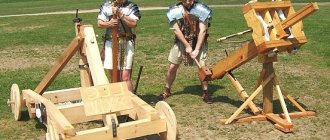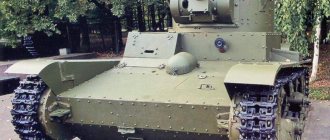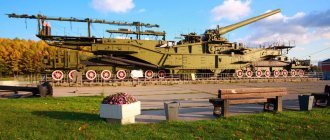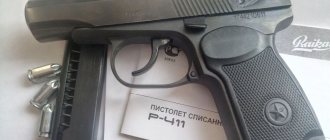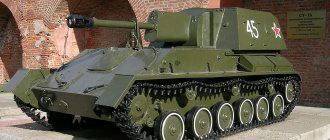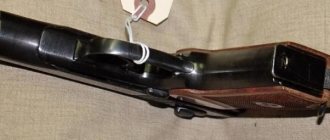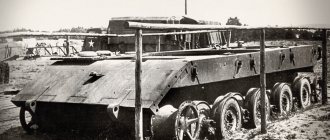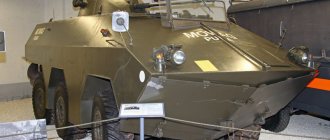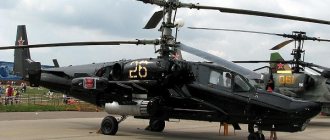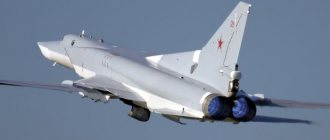203-mm howitzer B-4 model 1931 performance characteristics. Weight. Ammunition. Dimensions
The 203-mm B-4 howitzers of the 1931 model formed the basis of the Soviet high-power and special-power artillery of the RVGK. According to many military experts, including German ones, this howitzer was an unusual, but very effective artillery weapon. The development of the gun was started by the design bureau of Artkom GAU in 1927 in accordance with the decision of the Revolutionary Military Council of the USSR to re-equip high-power and special-power artillery with new domestic material.
History of creation
In November 1920, under the Artillery Committee (Artkom), which was headed by R. A. Durlyakhov, the Artillery Design Bureau was created under the leadership of F. F. Lender. It was in January 1926 that he was entrusted with the development of the “203-mm long-reach howitzer” project. After the death of F. F. Lander, the project was transferred to.
On December 11, 1926, at a meeting of Artkom, a decision was made: “To instruct the Artkom Design Bureau to develop a project for a 203-mm long-reach howitzer within 46 months...” By letter No. 51225/12Y5 dated March 22, 1927, the AK ordered the Artkom Design Bureau to draw up general projects 122- mm hull gun, 203 mm ARGK howitzers and 152 mm ARGK cannon. The howitzer project was completed on January 16, 1928 in two versions: with and without a muzzle brake. The gun bodies and ballistics were the same in both versions. Preference was given to a barrel without a muzzle brake. Working drawings of the swinging part of the howitzer were developed by the Artkom Design Bureau, and working drawings of the tracked carriage machine were developed by the Design Bureau. The first prototype of the 203-mm howitzer B-4 was manufactured at the beginning of 1931. In July - August 1931, firing tests were carried out at NIAP to select charges for the B-4. After lengthy field and military tests in 1933, the howitzer was adopted by the Red Army under the designation 203-mm howitzer mod. 1931
203 mm howitzer B-4 - video
Initially, the work on its creation was headed by designer F.F. Lander, and after his death designers of serial factories were involved in the work. After lengthy field and military tests in 1933, the howitzer was adopted by the Red Army under the designation “203-mm howitzer model 1931.” The howitzer was intended to destroy particularly strong concrete, reinforced concrete and armored structures, to combat large-caliber enemy artillery or covered with strong structures, and to suppress distant targets.
A special feature of the howitzer is its carriage with caterpillar tracks. The successful design of this carriage, which provided the howitzer with sufficiently high maneuverability and allowed firing from the ground without the use of special platforms, became unified for a whole family of high-power guns. The use of this unified carriage also made it possible to speed up the development and introduction into production of new high-power guns.
The upper carriage of the B-4 howitzer was a riveted steel structure. Using a pin socket, the upper machine was put on the combat pin of the lower machine and turned on it when the rotating mechanism was used. The firing sector provided in this case was small and amounted to only ±4°. To point the gun at a larger angle in the horizontal plane, it was necessary to turn the entire gun in the appropriate direction. The lifting mechanism had one gear sector. attached to the cradle. With its help, the gun could be aimed in a vertical plane in the angle range from 0° to +60°. To quickly bring the barrel to the loading angle, the gun had a special mechanism.
The anti-recoil system included a hydraulic recoil brake and a hydropneumatic knurler. All recoil devices remained motionless during the roll-up. The stability of the gun when firing was also ensured by a coulter attached to the trunk part of the lower machine. In the frontal part of the lower machine, cast shoes were fixed into which the combat axle was inserted. Caterpillars were put on the cone of the combat axis.
The crew of the Soviet 203-mm howitzer B-4 under the command of Senior Sergeant S. Szpin in the Sopot suburb of Danzig (now Gdansk, Poland) fires at German troops in Danzig. On the right you can see the Church of the Savior (Kościół Zbawiciela)
B-4 howitzers had two types of barrels: fastened without a liner and with a liner, as well as monoblock barrels with a liner. The liner could be replaced in the field. Regardless of the type of barrel, its length was 25 calibers, the length of the rifled part was 19.6 calibers. 64 grooves of constant steepness were made in the barrel bore. The bolt was a piston type, and both two-stroke and three-stroke bolts were used. The weight of the barrel with the bolt was 5200 kg.
The howitzer could fire a variety of high-explosive and concrete-piercing shells, including shells supplied from Great Britain to Russia during the First World War. The use of full and 11 variable charges was envisaged. In this case, the mass of the full charge was 15.0-15.5 kg of gunpowder, and the 11th - 3.24 kg. When fired with a full charge, the F-625D, G-620 and G-620Sh projectiles had an initial speed of 607 m/s and ensured the destruction of targets located at a distance of up to 17,890 m. Thanks to the large elevation angle (up to 60°) and variable charges, giving 12 different initial projectile velocities provided the ability to choose optimal trajectories for hitting a variety of targets. Loading was carried out using a manually operated crane. The rate of fire was 1 shot per 2 minutes.
At the position of the 203-mm howitzer B-4 of the Guard Sergeant Ivan Samoilov. 1st Ukrainian Front. As for the projectiles in the foreground (they seem too large), I’m certainly not an expert in photography, but it seems to me that this is simply the effect of enlarging objects in the foreground when the lens is brought close to them, this is perspective distortion (short-focus perspective). The shells are quite “original”.
For transportation, the howitzer was disassembled into two parts: the barrel, removed from the carriage and placed on a special cart, and the tracked carriage connected to the front - the carriage. The howitzer could also be transported unassembled over short distances. (This method of transportation was sometimes used during combat operations to deploy howitzers for direct fire at enemy reinforced concrete defenses.) For transportation, tracked tractors of the Kommunar type were used, the highest permissible speed on the highway was 15 km/h.
Howitzers of the 1931 model were mass-produced at 3 artillery plants, "Barricades" and the Novokramatorsk plant. Due to the fact that the technologists of each plant adapted the howitzer design to the production capabilities of their plant, the howitzers that entered service with the Red Army differed significantly from each other. This was not eliminated by the work carried out in 1937 to produce uniform drawings for all factories.
In total, by 1941, 977 howitzers of the 1931 model (B-4) of the standard modification BM (high power) and 31 howitzers of the MM modification (low power) were produced. distinguished by a barrel with a length reduced by 3 calibers. Mention should also be made here of the 203-mm self-propelled howitzer S-74, developed in 1943 by bureau designers under the leadership of V. G. Grabin. It was a chassis of the KV-1s tank, on which the rotating part of the B-4 howitzer was openly mounted. The installation was tested at the beginning of 1944, but it was not accepted into service with the Red Army.
B-4 howitzers took part in the Finnish War of 1939-1940. On March 1, 1940, there were 142 B-4 howitzers on the Finnish front. 4 B-4 howitzers were lost or failed (one in December 1939 and three in January-February 1940). By June 22, 1941, the Red Army had 849 B-4 howitzers, of which 41 howitzers needed major repairs.
By the beginning of the war, B-4 howitzers were only in high-power howitzer artillery regiments of the RVGK. According to the regiment's staff (as of February 19, 1941), it had four divisions of three batteries. Each battery consisted of 2 howitzers, respectively, one howitzer was considered a platoon. In total, the regiment had 24 howitzers. 112 tractors, 242 cars. 12 motorcycles and 2304 personnel (including 174 officers). By June 22, 1941, the RVGK had 33 regiments with B-4 howitzers. that is, there are only 792 howitzers in the state, but in fact the regiments consisted of 727 howitzers. From June 22 to December 1, 1941, 75 B-4 howitzers were lost. and 105 howitzers were received from industry during the war.
At the beginning of the war, several B-4 howitzers were captured by the Germans. So. In the city of Dubno, the 529th high-power howitzer artillery regiment was captured by the Germans. Due to the lack of tractors, our troops abandoned 27 203-mm B-4 howitzers in good condition. The captured howitzers received the German designation 20.3 cm HaubiUe 503 (g). They were in service with several heavy artillery divisions of the Wehrmacht RKG.
As for the Soviet high-power howitzer artillery regiments, most of them were withdrawn to the rear at the beginning of the war. They began to be actively used in combat operations from the end of 1942, when the strategic initiative was in the hands of the Red Army. By May 1, 1945, 30 brigades and 4 separate high-power artillery regiments of the RVGK had 760 203-mm howitzers of the 1931 model.
Characteristics of B-4 howitzer ammunition
— Loading: separate cap, it was planned to use full and 11 variable charges. In this case, the mass of a full charge was 15.0-15.5 kg of gunpowder, and one variable charge was 3.24 kg.
B-4 howitzer ammunition range
— High-explosive projectile F-625D — High-explosive projectile F-625 (with a screw head) — Concrete-piercing projectile G-620 — Concrete-piercing projectile G-620T — Projectile with a nuclear charge. Weight 150 kg. Firing range 18 km. Still in service.
Muzzle velocity of the projectile, m/s:
— High-explosive F-625(D): from 288 to 607 — Concrete-piercing: 607
B-4 howitzer projectile weight
— Weight of high-explosive projectile F-625(T), kg: 100 — Weight of concrete-piercing projectile G-625(T), kg: 100—146
Soviet artillerymen prepare a 203-mm howitzer B-4 to fire
Production
Production was organized simultaneously on two and "Barricades"). The greatest difficulties arose on. In 1933, this plant presented only one howitzer for delivery, but it could not be delivered until the end of the year. The first two B-4 howitzers were delivered in the 1st half of 1934. In 1940, the Novokramatorsky plant was involved in production, which was set an annual plan of 25 howitzers, while for the plant in Stalingrad it was 10 times larger.
Working drawings of the howitzer were changed at each plant, adapting to technological capabilities.
As a result, practically two different howitzers began to enter service. In 1937, unified drawings were worked out not by changing the design, but by assembling individual parts and assemblies that had already been tested in production and operation. The only innovation was that it was mounted on a caterpillar track, which allowed firing directly from the ground without special platforms. But complete unification of production howitzers and “Barricade” was not achieved. Serial production of B-4 howitzers
| Manufacturer | 1933 | 1934 | 1935 | 1936 | 1937 | 1938 | 1939 | 1940 | 1941 | 1942 | Total |
| Bolshevik/No. 232 (Leningrad) | 19 | 60 | 13 | 12 | 42 | 49 | 48 | 243 | |||
| Barricades/No. 221 (Stalingrad) | 15 | 75 | 181 | 165 | 300 | 3 | 739 | ||||
| NKZ (Kramatorsk) | 3 | 26 | 29 | ||||||||
| Total | 19 | 75 | 13 | 12 | 42 | 124 | 229 | 168 | 326 | 3 | 1011 |
Production of B-4 howitzers in 1941
| Manufacturer | 1st half of the year | July | August | September | October | Total |
| Barricades/No. 221 (Stalingrad) | 210 | 30 | 30 | 21 | 9 | 300 |
| NKZ (Kramatorsk) | 11 | 5 | 5 | 5 | 26 | |
| Total | 221 | 35 | 35 | 26 | 9 | 326 |
In total, from 1933 to 1942, 1011 B-4 howitzers were produced, of which 31 were low-power.
Tactical and technical characteristics of the B-4 howitzer
— Years of production: 1937—1941 — Produced: 889 pieces
Calculation: 15 people
Overall dimensions of the B-4 howitzer
Barrel — Caliber, mm: 203.2 — Barrel length, mm/club: 5087/25 — Channel length, mm: 4894 — Length of the rifled part, mm: 3981 — Rifling stroke length, clb: 20 — Number of riflings: 64 — Depth rifling, mm: 2.0 — Grooving width, mm: 6.0 — Field width, mm: 3.97 — Barrel weight with bolt, kg: 5200
Carriage — Angle VN, degrees: 0—60° — Angle GN, degrees: ±4° — Rollback length variable, mm: 850—1400 — Height of the firing line, mm: 1920 — Stroke width (in the middle of the tracks), mm: 1910 — System length in firing position, mm: 9365 — System width in firing position, mm: 2490 — Track width, mm: 460
Weight of howitzer B-4
— System in firing position: 17,700 kg — Weight in stowed position: 19,000 kg
— Recoiling parts with a barrel: 5440 kg — Swinging part: 7900 kg — Carriage: 12,500 kg — Weight of the carriage with limber: 13,800 kg
Gun cart Br-10 — Weight of empty cart, kg: about 5400 — Weight of cart Br-10 with barrel, kg: about 10 600
Gun cart with tractor-type wheels - Weight of the cart with barrel, kg: 9590
Gun cart B-29 (on tracks) — Weight of the cart without a barrel, kg: about 7700 — Weight of the cart with a barrel, kg: about 12,900
Firing range of the B-4 howitzer
— maximum firing range: 17.89 km
Rate of fire of the B-4 howitzer
- 1 shot per 2 minutes
Travel speed on roads, km/h: 5—15
Transition time from traveling to combat position, depending on the ground and time of year: from 45 minutes to 2 hours.
Tractor: AT-T, in the post-war period.
Morning execution
The rules did not allow for direct fire from B-4 howitzers. However, it was for conducting such fire that the commander of a battery of 203-mm guard howitzers, Captain Vedmedenko, received the title of Hero of the Soviet Union. On one of the sections of the Leningrad Front on the night of June 91, 1944, under the noise of a firefight that drowned out the roar of engines, tractors dragged two huge guns to the front edge. When the shooting died down and the movement of the guns was completed, the camouflaged guns from the giant pillbox - the target of the howitzers - were at a distance of 1200 meters. Reinforced concrete walls two meters thick; three floors going underground; armored dome; approaches covered by fire from flank bunkers - this structure was the main point of resistance of the enemy forces. And as soon as it began to dawn, Vedmedenko’s howitzers began shelling. For two hours, hundred-kilogram concrete-piercing shells methodically destroyed two-meter walls, and, finally, the fortress simply ceased to exist.
Photo of howitzer B-4
Soviet artillery tractor "Voroshilovets" towing a 203-mm howitzer B-4 on the outskirts of Berlin
Transportation of a barrel cart (“tractor type”) of a Soviet 203-mm howitzer B-4 through the streets of a destroyed German city. A Soviet automobile convoy is moving to the left of the transported barrel cart.
Soldiers load a 203-mm B-4 howitzer to fire at Finnish fortifications
Red Army soldiers cleaning a 203-mm howitzer B-4 on the Karelian Isthmus
Soviet 203-mm howitzer model 1931 (B-4), disabled and abandoned in the Dubno area
The crew of a Soviet 203-mm howitzer B-4 fires on one of the streets of Berlin
Soviet 203-mm howitzer model 1931 (B-4) during a parade in Kyiv. In the background, S-60 “Stalinets” tractor-tractors are towing 203-mm B-4 howitzers
A Soviet artillery gunner at the sight of a Soviet 203-mm high-power howitzer, model 1931 (B-4). The howitzer was aimed using the PG-1 artillery panorama (Hertz panorama). The fighter on his tunic has the badge “For excellent artillery training” (left) and the badge “GTO” (right). A cap charge has already been prepared in the loading cradle; the “chumadan” will soon fly to the Germans!
The crew of the Soviet 203-mm howitzer B-4 loads the gun
The crew of a Soviet 203-mm howitzer B-4 fires on the outskirts of Voronezh. The shell was sent, and on the tray there was already a powder cap in white cotton fabric. It is dangerous to shoot through branches; the fuse may go off. Probably they only shoot “high-explosive” and are not afraid of it. And for a specific purpose - they cleared a narrow opening, and are probably firing from a large elevation angle. The barrel is in loading position, almost horizontal. Shooting to kill - smoke is still coming from the first shot, and already the second shell is in the chamber. Before starting shooting, the first one is in the barrel, the second one is on the tray. The third one will not be so fast, you need to lift it onto a tray.
Soviet 203-mm howitzer B-4 (model 1931), captured by the Germans. The gun barrel, which was transported separately, is missing. 1941, presumably Belarus. German photo. Shirokorad claims that in the Dubno area the Germans captured 27 serviceable B-4 howitzers from the 529th high-power artillery howitzer regiment (perhaps they are in the photo). The Germans assigned them the designation 20.3cm N.503/1(r) and H.503/2(r) (the difference is in barrel length). As of March 1944, there were 3 N.503/1(r) howitzers on the eastern front.
Soviet artillerymen write on shells “To Hitler”, “To Berlin”, “Across the Reichstag”. The artilleryman, near the shell with the inscription “personally,” very likely has medals “For Military Merit” and “For the Defense of Moscow.” In the background is a 203-mm howitzer of the 1931 model (B-4), as far as I know, there are 100 kg “suitcases” in the photo.
Similar
SAU 2S7 Pion (2S7M Malka) performance characteristics.
Caliber. Dimensions. Firing range of MLRS BM-21 Grad. Damage area. Rockets. Caliber. Story
120-mm mortar 2B11 complex 2S12 Sani TTX. Firing range. Weight
Mortar 2B9M Vasilek 82 mm Rate of fire. Firing range. Weight
Self-propelled gun 2S3 Akatsiya 152 mm. Firing range. Dimensions. Weight. Engine
SAU 2S1 Gvozdika 122 mm Firing range. Dimensions. Device. Weight
Gun 2A36 Giatsint-B 152 mm. Firing range. Dimensions. Device
MLRS 9K58 Smerch Damage area. Rockets. Caliber. Story
MT-12 Rapier gun. Firing range. Story. Dimensions
Howitzer D-30 122-mm performance characteristics. Firing range. Dimensions. Weight
2S4 Tulip self-propelled mortar 240 mm performance characteristics. Dimensions. Firing range. Weight
Self-propelled gun 2S35 Koalitsiya-SV 152-mm performance characteristics. Firing range. Dimensions. Weight
Howitzer Msta-B (2A65) 152 mm. Firing range. Dimensions. Weight. Ammunition
Self-propelled gun 2S9 Nona-S 120 mm performance characteristics. Firing range. Dimensions. Weight. Armament
AT-T heavy artillery tractor. TTX. Dimensions. Engine. Story
SAU 2S19 Msta-S 152 mm Dimensions. Speed. Engine. Story
MLRS 9K57 Hurricane Damage area. Rockets. Caliber. Story
TOS-1 Buratino (TOS-1A Solntsepek) performance characteristics. Damage area
Divisional gun ZIS-3 76 mm. TTX. Firing range. Dimensions. Weight
Howitzer gun D-20 152 mm performance characteristics. Firing range. Dimensions. Weight
Howitzer M-30 model 1938 122-mm performance characteristics. Firing range. Dimensions. Weight
Self-propelled gun 2S5 Giatsint-S 152 mm performance characteristics. Firing range. Armament. Dimensions. Weight
Self-propelled gun Ferdinand (Elephant) performance characteristics. Reservation. Weight. Dimensions
Self-propelled gun SU-100. TTX. Armament. Dimensions. Shells. Weight. Speed
Self-propelled gun Sturmtiger caliber 380 mm. TTX. Armament. Shells. Reservation. Dimensions
203-mm howitzer B-4 model 1931 performance characteristics. Weight. Ammunition. Dimensions
Self-propelled gun SU-152 St. John's wort 152 mm performance characteristics. Shells. Firing range. Dimensions. Weight
Gun M-46 130-mm performance characteristics. Firing range. Dimensions. Weight
Demining installation UR-77 Meteorite TTX. Armament. Dimensions
MLRS 9K51M Tornado-G. Rockets. TTX. Firing range. Dimensions
SAU 2S31 Vienna 120 mm. Firing range. Story. Dimensions. Weight
German self-propelled gun StuG III. Modifications. Dimensions. Armament. Weight
Guided projectile Krasnopol. TTX. Firing range. Dimensions. Price
Mortar Karl 600 mm and 540 mm performance characteristics. Firing range. Weight. Dimensions
Big Bertha 420 mm gun. TTX. Weight. Dimensions. Ammunition
Self-propelled gun SU-76. TTX. Dimensions. Reservation. Weight. Story
SAU 2S23 Nona-SVK 120-mm performance characteristics. Armament. Range and accuracy of fire. Dimensions
SAU 2A3 Condenser-2P caliber 406 mm Firing range. Armament. Dimensions. Weight
Mortar M-160 caliber 160-mm performance characteristics. Firing range. Ammunition. Dimensions
Airborne self-propelled gun ASU-57. Armament. TTX. Dimensions. Weight. Booking
Artillery complex A-222 Bereg 130 mm. TTX. Firing range. Ammunition
Howitzer BR-18 caliber 305 mm TTX. Firing range. Weight
152 mm howitzer D-1. Firing range. Dimensions. Weight. Device
Mortar M-240 caliber 240 mm. Firing range. Dimensions. Weight
Self-propelled gun SU-85. Ammunition. Reservation. Dimensions. Weight. Engine
Counter-battery radar Zoo-1 (1L219M). Range of control of firing positions. Device
SAU 2S25 Sprut-SD. Caliber. Story. Dimensions. Weight. Engine
Self-propelled gun 2S34 Hosta 120 mm. TTX. Dimensions. Firing range. Armament. Weight
Self-propelled gun ASU-85. Armament. Dimensions. Reservation. Weight
280-mm mortar Br-5 model 1939 Dimensions. Weight. Ammunition
Self-propelled gun 2A45M Sprut-B. TTX. Speed. Engine. Weight
Belarusian MLRS BelGrad. TTX. Firing range. Ammunition. Dimensions
S-23 cannon 180 mm caliber. Ammunition. Weight. Dimensions. Firing range
Self-propelled gun SAU SU-122. Dimensions. Armament. Reservation. Weight
Self-propelled gun Jagdpanther. Weight. Reservation. Dimensions. Armament
Multi-barreled self-propelled gun M50 Ontos. TTX. Armament. Dimensions. Booking
D-74 cannon 122 mm caliber. Firing range. Dimensions. Weight
Artillery tractor YA-12. Dimensions. Weight. Load capacity. Engine
Artillery tractor T-20 Komsomolets. Armament. Reservation. Dimensions. Weight
SAU ISU-122. Armament. Dimensions. Weight. Booking
RPU-14 (8U38) - rocket launcher
MLRS BM-24 (T) 240 mm. Firing range. Dimensions. Weight. Engine
2K32 Deva - 82-mm self-propelled mortar system
Artillery tractor Comintern. Load capacity. Dimensions. Weight. Engine
Self-propelled gun SU-122-54. Reservation. Dimensions. Weight. Firing range
MLRS BM-14-16. Armament. Dimensions. Weight. Firing range
Self-propelled gun Nashorn (Rhinoceros). Armament. Dimensions. Weight. Booking
BR-2 gun caliber 152 mm. Firing range. Dimensions. Weight
Self-propelled howitzer self-propelled gun PzH 2000. Firing range. Dimensions. Weight
BR-17 cannon 210 mm caliber. Weight. Firing range. Rate of fire
Self-propelled gun Vespe 105 mm. Armament. Dimensions. Reservation. Weight
Wheeled self-propelled gun GAZ-68 (KSP-76). Armament. Dimensions. Weight. Engine
Self-propelled gun Brummbar 150 mm. Armament. Dimensions. Weight. Booking
Heavy self-propelled gun SU-14. Reservation. Dimensions. Weight. Engine
Self-propelled gun SU-5. Armament. Reservation. Dimensions. Weight
Self-propelled gun AT-1. Reservation. Dimensions. Weight. Engine
Self-propelled gun SU-12. Armament. Reservation. Dimensions. Weight
Practical “benefits” of discrediting the Soviet Union
Deputy Chairman of the World Coordination Council of Russian Compatriots Maxim Kramarenko, in an interview with the portal Nakanune.RU, explained the problem of revanchism by saying that in this way they want to make Russia the legal successor of a country that is supposedly, in equal measure with Germany, responsible for the outbreak of the Second World War.
Kramarenko explained that in the end they will simply try to expel Russia from the UN Security Council. It is for this purpose that a global project is now being implemented to create a new narrative, a new reading of the history of the Second World War.
Kramarenko emphasized that it is necessary to fight this trend, for which purpose a proposal was put forward to enshrine in the Constitution an amendment that would protect the memory of the people’s feat in the Second World War.
"Karelian sculptors"
The B-4 large-caliber howitzer first demonstrated its power during the Soviet-Finnish war of 1939-1940. Then the Red Army had to overcome the heavily fortified Finnish positions on the Karelian Isthmus. In violation of all regulations and instructions, the howitzers moved forward for direct fire and shot at Finnish fortifications almost point-blank. Explosions of hundred-kilogram shells on the domes of the pillboxes led to the defenders’ eardrums bursting and their noses bleeding. Many could not stand the fear and panic and went crazy. The Finns nicknamed the B-4 howitzers “Stalin's sledgehammers” and feared them like fire.
Howitzer B-4 model 1931:
1 - Wheel devices for transporting a howitzer.2 - 203 mm projectile.3 - Bed.4 - Drive sprocket.5 - Breech.6 - Sloth.7 - Platform for brakes (crew numbers that control the trolley brakes on the march).8 - Recoil device.9 - Howitzer barrel.10 - Wire winch.11 - Trolley with rollers.
It happened that, having learned that the Russians had brought these terrible guns to their defense area, the garrisons of the pillboxes left them in panic. Sometimes even powerful 203-mm shells could not penetrate the thick reinforced concrete of the Finnish fortifications, but from the shock caused by the explosion of a powerful shell, the domes and walls of the pillboxes were cracked. And after a dozen or two direct hits, instead of the Finnish fortification, a bizarre composition of fragments of concrete and intertwined steel reinforcement rose above the ground. The Red Army soldiers called such figures “Karelian monuments,” and the artillerymen serving the B-4 howitzers “Karelian sculptors.” After the start of the Great Patriotic War, artillery regiments armed with 203-mm howitzers were hastily withdrawn to the rear and entered combat only at the end 1942, when the strategic initiative began to gradually pass into the hands of the Red Army. The 203-mm howitzer of the 1931 model justified all the hopes placed on it. It was successfully used both in breaking through fortified zones, and in storming fortresses, and in street battles in large cities. With its help, impregnable forts in Königsberg, Poznan, and Breslau were defeated. The artillerymen, remembering the experience of using these guns during the Soviet-Finnish war, during the assault on Berlin in the spring of 1945, rolled out B-4 howitzers for direct fire and destroyed the long-term fortifications of the capital of the Third Reich with heavy shells. During the fierce battles of 1941, several B- howitzers 4 were captured by the Germans. Some of them entered service with the German army under the name 20.3 cm N.503(g). By March 1944, on the Eastern Front, the Germans had eight 20.3-cm N.(g) howitzers, the shots for which were composed of captured Soviet 203-mm G-620 concrete-piercing shells and German charges. In addition to the Eastern Front, captured Soviet howitzers were used by the Germans on the Western Front and in Italy.
How she was “changed”
For all its advantages, the B-4 howitzer had one drawback - the speed of its transportation along the highway was very low. Therefore, even during the war, designers began developing a project for a new wheeled carriage for the B-4 howitzer. The project was carried out on its own initiative at OKB-221 in Stalingrad. From 1947 to 1954, the entire fleet of howitzers in service with the Soviet Army was repaired. By that time, the Kommunar tractor, which was used as a tractor, was replaced by a heavy artillery tractor (AT-T), which reached speeds of up to 35 km/h. The B-4 tracked undercarriage could not withstand such a speed and was destroyed. The technical design of the new carriage was completed in April 1954, and in December 1954, two experimental carriages with a 203.4 mm B-4 howitzer and a 152 mm gun installed on them Br-2 were sent for testing. The new wheeled carriage was adopted by the Soviet army in 1955. The howitzer on the new carriage received the designation B-4M. By that time, a projectile with a nuclear charge had been developed for the B-4 and B-4M howitzers. It weighed 150 kg and could be fired at a target at a distance of 18 km. This projectile is still in service with the Russian army.
Notes[edit]
- ^ abcdefg Foss, Christopher (1977). Jane's Pocket Book of Towed Artillery
. New York: Collier. paragraph 139. ISBN 0020806000. OCLC 911907988. - ↑
Bishop, Chris. Encyclopedia of weapons of the Great Patriotic War. Sterling Publishing Company, Inc., 2002, p.132. - "Archival copy". Archived from the original on 2014-12-16. Retrieved 5 September 2015.CS1 maint: archived copy as title (link)
- ↑
Bishop, Chris. Encyclopedia of weapons of the Great Patriotic War. Sterling Publishing Company, Inc., 2002, p.131. - ISIS military equipment # Explosives, anti-tank weapons, grenade launchers and anti-aircraft guns
